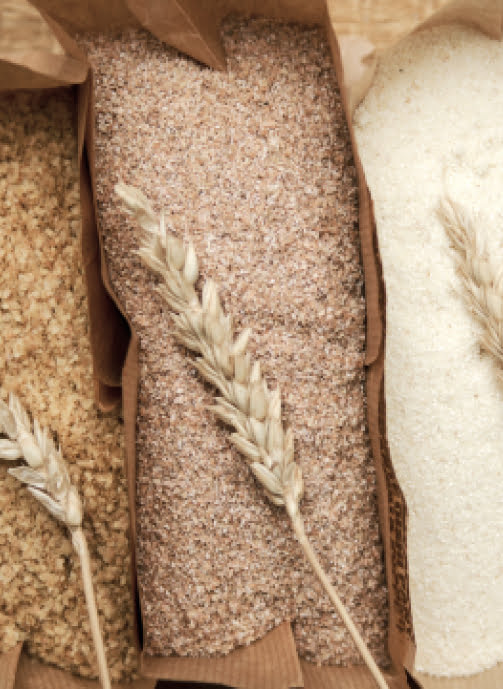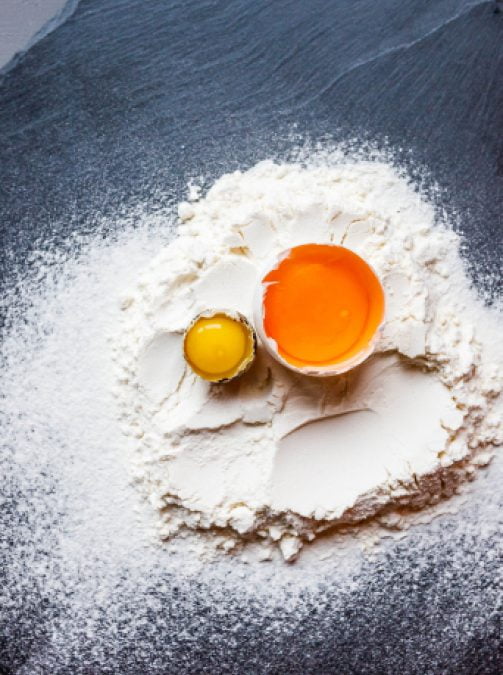
UNBLEACHED WHITE: Creamier in colour than white, bleaching involves treating the flour with chlorine. In Britain flour producers are required by law to add or fortify white flours with certain nutrients – Vitamin Bl, Nictinic acid, iron and calcium, often added in the form of white Soya flour which has a natural bleaching effect.
STRONG WHITE: Derived from wheat high in protein. Proteins in the flour when mixed with water combine to make gluten and this gives dough its elasticity when kneaded, which traps air bubbles of Carbon Dioxide given off by the yeast.
FINE FRENCH PLAIN FLOUR: French bakers use a mixture of white bread flour and fine plain flour to make breads. This is called FARINE FLU I DE – which is light and free flowing.
WHOLEMEAL FLOUR: Uses the· whole what grain, sometimes known as 100% extraction flour. Nothing is added and nothing is taken away.
GRANARY FLOUR: This is a blend of brown, rye and malted grain. The malted grain gives a slightly sticky and sweet flavour and texture.
BROWN FLOUR: 85% original grain, some of the bran and wheat germ is extracted. Produces a lighter loaf than 100% Wholemeal.
SEMOLINA: This is the wheat kernel or endosperm, once the bran and wheat germ have been removed from the grain by milling, but before it is fully milled into flour.

BUCKWHEAT FLOUR: The grain is blackish in colour; hence the French name BLE NOIR. It is not really a cereal but the fruit of a plant belonging to the Dock family. It has an earthy flavour.
CORNMEAL (Maize meal): This is ground from white or yellow corn, can be coarse/medium or fine milled. The corn contains no gluten and will not make a loaf unless blended with wheat flour. Corn adds a pleasant flavour and colour.
MILLET FLOUR: This is high in protein, but low in gluten and is also not normally used by itself. It is pale yellow in colour and has a gritty texture. Once mixed with wheat flour it produces a slightly nutty flavour.
OATMEAL: This doesn’t contain any gluten and is rarely used by itself in bread making.
RICE FLOUR: Polished rice if ground very finely becomes rice flour. It is used as a thickening agent and is very useful for people with wheat allergies.
RYE FLOUR: This is the only other cereal apart from wheat that is used widely to make bread. It has a good gluten content, however the gluten present in Rye is different from the gluten in wheat, therefore rye dough’s are difficult to handle as they are very soft and sticky. For this reason rye is normally blended with other flours.
Read More
Yeast is the most popular; however Bicarbonate of Soda and Baking Powder can be used.
NATURAL LEAVENS: Are made using a medium of flour, or grown from potatoes – yoghurt, treacle or buttermilk can also be used.
SOURDOUGHS: These are breads based on natural leavens. Authentic Sourdough relies entirely on the wild yeast that exits in the air. Given the right conditions any dough of flour and water will start to ferment and will continue to do so if starch or sugar is added to feed it.
In France the Sourdough method is known as ‘THE CHEF or LEVAIN’. They begin with a
‘STARTER’ -which can take anything up to a week to ferment. Some Starters have been known to survive for many years. The Italian Starter is known as ‘BIGA’ and this is a similar product, produced from flour, water and yeast, which is left for approx 15 hours and then added to the bread.
In Britain Sourdoughs are sometimes called Acids or acid breads and in Ireland soda was a popular leaven along with ale Barm (the fermentation liquor from beer) was commonly used until it was replaced by bakers yeast around the middle of the last century.
Read MoreHAVE A QUESTION?
Talk to the Chef



